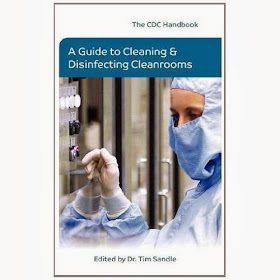Cleaning and Disinfection Handbook
Contamination control is of great importance to healthcare facilities
and to pharmaceutical cleanrooms. With healthcare, the more immediate
concern is with protecting the patient from infection (infection
prevention practices aim to eliminate the risk of the transmission of
pathogens between patients and between patients and the health care
worker). With pharmaceuticals the concern is with avoiding contamination
of the product being prepared so that the product is safe for use. Both
healthcare facilities (from hospital wards to pharmacy units) and
pharmaceutical facilities share a number of similarities, from the
importance of hand sanitization to the control of cleanrooms.
The key interconnecting aspect is the use of cleaning agents
(detergents) and disinfectants. Therefore designing an effective
cleaning and disinfection program is a critical part of the
contamination control approach. Whilst there are a myriad of different
agents on the marketplace, not all are suitable for cleanrooms, hands or
hospital wards. To add to this there is a sometimes bewildering choice
of different chemicals with different modes of action, many of which are
incompatible with one another. From this there is often ambiguity about
how such agents should be used including questions of ‘how often should
I use this?’, ‘how do I dilute it?’, ‘how long do I leave it for?’
coupled with confusion over cleaning methods and techniques. In relation
to these issues it became clear that there was no book, of smaller
size, which addressed these issues for those concerned with keeping
hospitals and cleanrooms clean. In light of this, the idea for a book - “The Cleaning and Disinfection Handbook” - was born.
For a
free excerpt from the book,
click here.
For the press release,
click here.
The book is available from Amazon worldwide:
Amazon.com Amazon U.K.
Amazon Austria Amazon Canada
Amazon China Amazon France
Amazon Germany Amazon Italy
Amazon Japan Amazon Spain
Amazon India Amazon worldwide
Here are some further details:


‘The CDC Handbook’, a new ‘Guide to Cleaning & Disinfecting
Cleanrooms’ has just been published and is available as a paperback and
an e-Book. Edited by Dr Tim Sandle, a pharmaceutical microbiologist, the
CDC Handbook has contributions from expert practitioners actively
involved in contamination control within clean areas and controlled
environments. It has been written for those working in both the
pharmaceutical and healthcare sectors, as well as providing valuable
information for students and the general reader. The illustrated
Handbook balances theoretical concepts with sound practical advice. It
provides comprehensive detail about different types of disinfectants and
their modes of action; explains the problems of microbial destruction
and resistance; introduces cleaning techniques and the latest safety
regulations and expounds upon the application of cleaning within
healthcare and pharmaceutical environments, noting current national and
international standards. To help less experienced readers, the book
contains a glossary of terminology.


The book’s editor and main contributor, Dr Sandle says: ‘The use of
detergents and disinfectants is a critical part of the contamination
control approach. There are a myriad of different agents, but not all
are suitable for cleanrooms, hands or hospital wards. Also, there is a
sometimes bewildering choice of different chemicals with different modes
of action, many of which are incompatible with one another. There is
often ambiguity about how such agents should be used including questions
of 'how often should I use this?', 'how do I dilute it?', 'how long do I
leave it on for?' coupled with confusion over cleaning methods and
techniques. In relation to these issues it became clear that there was
no handbook which addressed these issues for those concerned with
keeping hospitals and cleanrooms clean. In light of this, the idea for
this book - "The Cleaning and Disinfection Handbook" - was born.’
‘In putting this book together, some of the leading experts in the field
of contamination control, working either in healthcare or the
pharmaceutical industry, were approached. In agreeing to contribute to
this book each person has written a high quality chapter and has helped
to put together what is a unique book on cleaning and disinfection. The
book is subtitled "a handbook" and this is the operative word that, as
editor I would most like to see applied. This is not a book intended to
sit on a shelf and gather dust, it is a book intended to be read and
discussed by those with the very important task of keeping cleanrooms,
hospitals and the hands of staff, clean. If "The CDC Handbook" becomes
an established part of the educational resources available to the
workforce who aim to keep critical areas clean, then the aims and
intentions which shaped this book will have been a success.’
Posted by Tim Sandle


No comments:
Post a Comment
Pharmaceutical Microbiology Resources